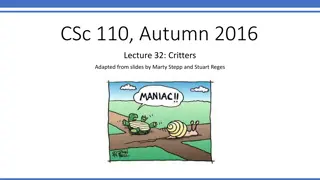
Introduction to Ant Build Tool for Java Development
"Discover the benefits of using Ant, a Java-based build tool for software projects. Learn about the importance of build processes, why Ant is a preferred tool, and core concepts such as XML format and declarative syntax."
Download Presentation

Please find below an Image/Link to download the presentation.
The content on the website is provided AS IS for your information and personal use only. It may not be sold, licensed, or shared on other websites without obtaining consent from the author. If you encounter any issues during the download, it is possible that the publisher has removed the file from their server.
You are allowed to download the files provided on this website for personal or commercial use, subject to the condition that they are used lawfully. All files are the property of their respective owners.
The content on the website is provided AS IS for your information and personal use only. It may not be sold, licensed, or shared on other websites without obtaining consent from the author.
E N D
Presentation Transcript
Software Development COMP220/COMP285 Seb Coope Introducing Ant These slides are mainly based on Java Development with Ant - E. Hatcher & S.Loughran. Manning Publications, 2003
Introducing Ant Ant is Java based build tool which is - easy to use, - cross-platform, - extensible, and - scalable. It can be used either in - small personal or - large, multi-team software projects. 2
What is a build process and why do we need one? In order to build a software product, we manipulate our source code in various ways: compile generate documentation unit test package deploy 3
What is a build process and why do we need one? Initially this can be done manually. But when we are tired of doing repetitive actions, we look for tools, that can ease the burden of repetitions. 4
Why Ant is a good build tool? Ant has a very simple syntax which is easy to learn easy to use cross-platform is very fast uses its own JVM, reducing start-up delays does tasks dependency checking to avoid doing any more work than necessary 5
Why Ant is a good build tool? integrates tightly with JUnit test framework easily extensible using Java can be used for automated deployment de facto standard for most open source Java projects 6
Why Ant is a good build tool? Because Ant understands testing and deployment, it can be used for a unified build-test-deploy process. In a software project experienced constant change, an automated build can provide a foundation of stability. Ant is the means of controlling the building and deployment that would otherwise overwhelm a team. 7
The Core Concepts of Ant To understand Ant, you need to understand the core concepts of Ant build files: XML format declarative syntax 8
The Core Concepts of Ant A build file contains one project (to build, test, deploy, etc.) Large projects may be composed of - smaller subprojects, each with its own build file - a higher-level or master build file can coordinate the builds of subprojects 9
The Core Concepts of Ant Each Antproject contains multiple targets to represent stages in the build process: - compiling source, - testing, - deploying redistributable file to a remote server, - etc. Targets can have dependencies on other targets: - e.g. redistributables are built, only after sources get compiled 10
The Core Concepts of Ant Targets contain tasks doing actual work Ant has various predefined tasks such as <javac>, <copy> and many others New tasks can easily be added to Ant as new Java classes - because Ant itself is implemented in Java It may be that somebody have already written a specific task you need; - so you can use it (or vice versa) 11
An example project The next slide shows the conceptual view of an Antbuild filebuild.xml - as a graph of targets, - each target containing the tasks. The Ant run time determines which targets need to be executed, and chooses an order of the execution that guarantees a target is executed after all those targets it depends on. If a task somehow fails, the whole build halts as unsuccessful. 12
OurProject : Project Arrows show dependencies between targets init:Target <mkdir>:Task <mkdir>:Task compile:Target <javac>:Task doc:Target <javadoc>:Task deploy:Target <jar>:Task <ftp>:Task 13
File build.xml: <?xml version="1.0" ?> <project name="OurProject" default="deploy"> <target name="init"> <mkdir dir="build/classes" /> <mkdir dir="dist" /> </target> <target name="compile" depends="init" > <javac srcdir="src" destdir="build/classes" includeAntRuntime="no"/> </target> <target name="doc" depends="init" > <javadoc destdir="build/classes" sourcepath="src" packagenames="org.*" /> </target> (continues) 14
<target name="deploy" depends="compile,doc" > <jar destfile="dist/project.jar" basedir="build/classes"/> <ftp server="${server.name}" userid="${ftp.username}" password="${ftp.password}"> <fileset dir="dist"/> </ftp> </target> </project> Compare yourself the values of depends attribute with the structure of the above graph. Let us look at the output of our build to get some impression on the whole process. 15
C:\OurProject>ant propertyfile ftp.properties Buildfile: C:\OurProject\build.xml init: [mkdir] Created dir: C:\OurProject\build\classes [mkdir] Created dir: C:\OurProject\dist compile: [javac] Compiling 1 source file to C:\OurProject\build\classes doc: [javadoc] Generating Javadoc ... deploy: [jar] Building jar: C:\OurProject\dist\project.jar [ftp] sending files [ftp] 1 file sent BUILD SUCCESSFUL Total time: 5 seconds 16
An example project (cont.) An example project (cont.) Note, that the command >ant invokes by default the file named asbuild.xml. The command we used above >ant propertyfile ftp.properties invokes additionally property file ftp.properties 17
An example project (cont.) ftp.propertiesfile contains three properties (parameters) server.name=ftp.texas.austin.building7.eblox.org ftp.username=kingJon ftp.password=password The property handling mechanism allows parameterisation and reusability of our build file. On the other hand, using as above the command-line option -propertyfile is also atypical . It is used in exceptional situations where override control is desired, such as forcing a build to deploy to a server other than the default server.name already described directly in build.xml. 18
The Beauty of Ant: Specify the build file correctly, and Ant will work out dependencies and call the targets (with their tasks) in the right order. One or two lines of XML is often enough to describe what you want a task to do. 19
The Beauty of Ant: Imagine also how useful is Ant build file if a new developers join a team. Imagine how many build errors could you make manually, without such a tool as Ant. Even very complex build repeated with Ant will give always the same standard result. 20





















